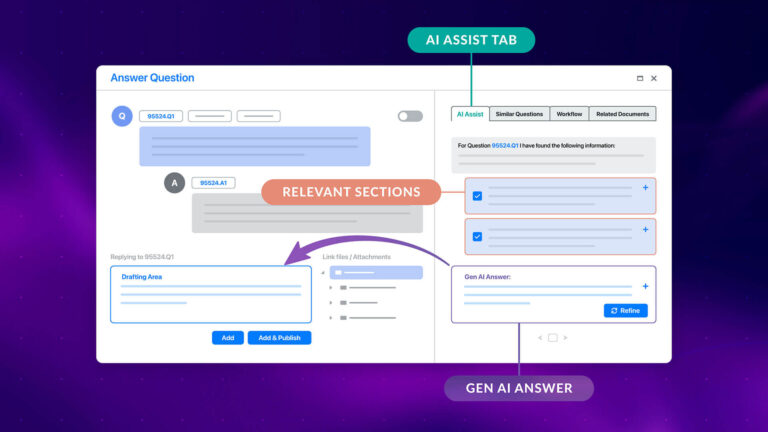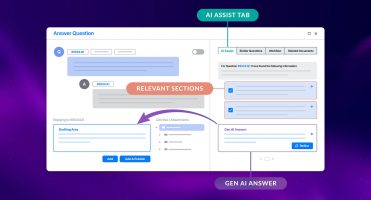Fears that artificial intelligence technology would automate professional jobs and create mass redundancies swept through the legal sector a few years ago – as it did through many professional services industries. While those fears have proved unfounded, AI technology is beginning to change how legal due diligence is conducted.
Today, the use of artificial intelligence (AI) in the legal due diligence process has been a part of the industry for a few years. Now that the dust has somewhat settled, it is time to separate the hype from reality and see how top tier lawyers are using AI-based tools day-to-day, and to examine the challenges and the benefits of using such software, as well as to look at the future of the legal due diligence process and of the legal profession.
The adoption of AI tools for the legal industry has not eliminated the need for human insight, and in fact, could help law practitioners unleash greater potential by automating repetitive tasks and allowing them to spend more time on higher-value tasks.
An important thing to remember is that human oversight will always be needed. I don’t believe that any lawyer will ever blindly rely on AI technology. It is envisaged, however, that the more mundane and repetitive tasks are going to disappear. These are exactly the type of tasks that humans don’t like and that machines thrive on.
PIETER VAN DER MADE, IMPRIMA
With this in mind, Mergermarket asked five experts in M&A from the law and technology fields to weigh in on trends in the use of artificial intelligence in legal due diligence processes and the future of the legal profession.
- Helen Bradley – Head of Corporate Finance, Baker McKenzie
- Emma Danks – Head of Private Equity Team, Taylor Wessing
- Dr. Pierre G. Zickert – Manager Legal Technology & Senior Associate, Hengeler Mueller
- Stacey Rickford – Strategic Operations Director, Travers Smith
- Pieter van der Made – Executive Chairman, Imprima
1. The state of legal due diligence
The legal due diligence process is a complex one, involving the review of countless numbers of contracts and documents. Pain points include not only the review of those documents but also compiling and sorting them at the start of the process.
Mergermarket: What is the purpose of legal due diligence in an M&A process and how does it differ from other types of due diligence processes in an M&A deal?
Stacey Rickford, Travers Smith: Legal due diligence is focused on understanding the operating framework of a business from a legal perspective, and whether the risks inherent in that framework are material in the context of the sector or the industry in which that business operates.
There are other types of due diligence that law firms are not directly involved in, including financial due diligence and commercial due diligence.
One of the big differences between legal due diligence and other types of due diligence is probably the structure of the information being looked at.
Legal due diligence typically involves the review of thousands of documents written in natural language – so, a lot of contracts – whereas other types of due diligence likely involve interrogation of data that is stored in structured databases.
A lot of financial due diligence will be looking at Excel sheets for example. And perhaps, for this reason, legal due diligence is less black and white than other forms of due diligence. When we do legal due diligence, we provide the buyer with a risk assessment rather than a factual
Pierre G. Zickert, Hengeler Mueller: When you look at legal due diligence, its basic function is the review of documents that are readily provided and identify legal risks. But that is not the entire process – the next step is to identify information gaps, ask the right questions, find additional information that wasn’t provided, and of course to evaluate legality, as well as where risks and opportunities lie. Beyond that, however, you must never lose sight of the commercial perspective, to see the broader picture of how the information you’re reviewing and the risks you’re identifying fit into the overall commercial logic of the deal.
Mergermarket: What are the typical pain points when it comes to conducting legal due diligence? How are software solutions used in the process?
Emma Danks, Taylor Wessing: When thinking about typical pain points, a lot has changed over the past 20 years. When I started having to do legal due diligence as a junior associate, we would go into a physical data room. That aspect of the process – access to the documents and understanding what’s in them – is obviously far more efficient than it used to be.
But even with the use of technology in this process, I think there is still a major pain point around just the process of sorting through those documents to identify key issues, and then putting together a report that has contributions from many different lawyers – including from local counsel overseas. Software solutions have greatly eased that process, and now facilitate consistency of approach and output.
Stacey Rickford, Travers Smith: I am just about old enough to remember when it was all done manually, but essentially these days, reading, reviewing, reasoning, tracking – all of that is done with a combination of virtual data rooms for reading and reviewing, Excel generally for tracking and reasoning, and then PowerPoint, or more often Word, for client presentation. And email – people still like email.
There have been other technologies that have looked to improve the process, mainly web-based tech that looks to improve or looks to almost introducing collaboration features during the review process. But I think they’ve seen limited success over and above the standard Windows suite.
Legal due diligence typically involves the review of thousands of documents written in natural language, whereas other types of due diligence likely involve interrogation of data that is stored in structured databases.
Stacey Rickford, Travers Smith
2. How AI is changing legal due diligence
Although legal due diligence is typically a very labour-intensive and repetitive process, it is nonetheless difficult to automate due to the fact that it involves the review of large amounts of unstructured data. Although enthusiasm among the legal industry for AI tools is high, there are important limitations to the technology which law firms must keep in mind.
Mergermarket: What processes in legal due diligence can already be improved or automated by AI?
Emma Danks, Taylor Wessing: First, AI can enable us to scope the projects out. For example, if we have a data room full of documents and those documents relate to a target group that has subsidiaries in many jurisdictions, we can use an AI tool to help us to scope out what we’re going to need to do, including which local counsel we will need to involve depending on the governing law of the documents to be reviewed.
But secondly, AI tools are very well-suited to assisting the review of documents or contracts which are quite commoditised. Leases are an obvious example. Supply agreements are another, where often a business will have one standard form that it rolls out multiple times, so as part of our review, we’re just looking for something which might slightly vary from that. So that’s where AI is incredibly useful because it can identify variations to a standard contract more efficiently than a team of lawyers, allowing the lawyers to focus on analysing the consequences of those variations.
Helen Bradley, Baker McKenzie: I think you have to really understand what AI can and cannot do for you. And you need to be clear about that with your clients. At the minute, AI can do a very sophisticated extraction or identification of data, but then someone has got to review it. From our experience, it is reliable. It’s not perfect, and probably similar quality to a human review. So, there are huge efficiencies in identifying the relevant information, but then someone is going to have to take all of that data and do something with it. You couldn’t present the extracted data ‘as is’ to a client, but it does save us time on a big contract review – it can save 50% of the time typically taken for the initial review.
Pierre G. Zickert, Hengeler Mueller: Just to add, artificial intelligence is somehow overrated and underrated in both ways. One might say AI was at least overhyped at the beginning. Some say this is not true. It is only overrated if you are under the impression that it can completely automate due diligence. AI allows you to perform the legal work without the pain of doing all the paperwork, to see and structure the information and to get to where you can actually work with your legal mind. And this is the point one usually underrates. Without having to filter, sort and structure the data first, one can perform high-end legal work from the start. This is a huge advantage and a huge change to how hours were spent in the past.
Pieter van der Made, Imprima: AI is able to automate a number of tasks and present information to the lawyers in a much more efficient way – processes such as document categorisation, finding agreements that contain certain clauses and finding clauses in those agreements. It is indeed true that the last task needs human oversight – trained lawyers still need to review the information. The latter is not a problem as we do not assume that any lawyer will blindly rely on AI anyway.
Mergermarket: How willing are lawyers and law firms to embrace and adopt emerging AI technology in legal due diligence processes?
Pieter van der Made, Imprima: There appears to be great interest, and willingness to adopt it, and we know many law firms have embarked on trialling AI tools already. Not too many seem to be actually using it in daily practice yet though. One key factor for this is some of the earlier AI tools out there have not fully met the lawyers’ expectations. Some of the first to market AI vendor tools lacked the ability to deal with different languages, or lack flexibility in general and required too much effort to set up. We do see though that, even in those situations, law firms remain interested in evaluating new AI technologies.
Stacey Rickford, Travers Smith: Very willing – but we must be quite careful about how AI complements our legal services. For example, if a client had 100 customer agreements, they might say to us, we only want the top 10 to be reviewed – that would be typical. We might then offer a tech-assisted review of the other 90, free of charge, provided the client understands the technology’s limitations and the potential shortcomings in the search results.
Mergermarket: What are the current limitations of AI tools in the legal due diligence process?
Helen Bradley, Baker McKenzie: Even as a reliable extraction tool, AI still has a way to go. For example, some of these contracts that you might review will be amended five or six times over the life of the contract. Every amendment is on a separate piece of paper and each refers to a contract papered in another contract.
Clients sometimes have unrealistic expectations. But, at the end of the day, once we explain to the client what the technology can and cannot do, they understand.
Helen Bradley, Baker McKenzie
Currently, we have found that AI treats these as separate contracts, and whilst it can link amends (parent and child functionality) it cannot summarise the effect of the five or six amends and produce a competent review of the end product. Our lawyers still need to do that.
Stacey Rickford, Travers Smith: I think we will have to get to a point where the AI is better at understanding natural language agreements and has a much higher level of accuracy. At the moment, it’s just not accurate enough. Put another way, if the AI picks something up then you can be fairly sure that it’s picking it up correctly but if it doesn’t return any results then you have no idea whether that thing exists or not, so you have to review everything yourself. Our view is that the quickest way for us to get to that point is for all law firms to share their AI-based models so that the AI is able to learn from as many documents as possible. But because of data privacy limitations, it is not possible to do that presently.
That said, even if we got to 100% accuracy, AI tools would still have their limitations – whilst they can assist lawyers by cutting through some of the admin on large transactions, they cannot provide a detailed risk assessment or provide bespoke commercial advice to that particular buyer as it pertains to that particular transaction.
Mergermarket: How do your clients, the corporates or PEs, in M&A processes, feel about the use of AI in due diligence processes? Is there enthusiasm for these new technologies or scepticism?
Emma Danks, Taylor Wessing: Definitely increasing enthusiasm and awareness. This is partly because of the type of clients we work for – a lot are tech businesses or investors in them. They are disruptive in their industries and they expect us to be tech-savvy as well, and our processes to be tech-enabled. In pitches, we are also seeing clients increasingly ask us questions such as, “How are tech tools going to help you run this M&A deal in an efficient way?” Our technology innovation team is becoming more and more involved in our business development activities, and our lawyers are working very closely with them – there is a real collaboration around tech solutions in this way.
Helen Bradley, Baker McKenzie: I think it has been embraced by all of our clients. The problem is that there has been a lot of hype, and clients sometimes have unrealistic expectations. But at the end of the day, once we explain to the client what the technology can and cannot do, they understand.
But overall, law firms have got to be using it these days, not just because clients demand it but also to hire and retain high-quality talent. Junior lawyers don’t want to spend all day and night in data rooms carrying out largely non-legal tasks. We want our juniors to be doing what junior lawyers should be doing, not administrative tasks like sorting data. So, for the sake of our junior employee’s career development, bringing in AI and other technological tools is the way to go.
Mergermarket: What are the biggest challenges to increasing adoption of AI tools in the legal sector? Which conditions have to be met for implementation of AI at law firms?
Pierre G. Zickert, Hengeler Mueller: One major challenge is making the cultural change. First of all, a lawyer has to be willing to try something new and then trust the technology. The first part of that is usually easy to do since you are promising a new world where everything is easier. The second point is harder – you don’t want to lose trust because the quality wasn’t what you promised. Therefore, ensuring the quality of the technology is up to par is essential. Moreover, one should start out small, get people on board with functionalities everyone can easily master, then continue step by step.
By doing this, you will also learn what the limitations of the technology are, and understand how to adapt to it. That way, you avoid any technology being perceived as overrated or not fully developed.
Pieter van der Made, Imprima: Up until this point, one of the main challenges has been the precondition that law firms had to invest significant internal resources to label a large amount of documents in order to train the algorithms before being able to use the AI. Clearly, this will hamper the speed of widespread adoption, because law firms simply don’t have the time to do that. At the same time, law firms do not necessarily want to rely on the training that has been done by the vendors of the AI technology either, because they have their own standards as to how documents should be reviewed. Another issue is that once trained, the AI is language and jurisdictionally dependent because it is trained on a certain set of agreements – from a certain jurisdiction and/or in a certain language.
Therefore, we have designed our AI tools at Imprima such that they do not require any pre-training. Instead, the AI learns from lawyers’ behaviour while they do their normal review work. As a result, law firms can benefit from significantly improved accuracy as well as large time savings without the upfront time investment.
3. The future of AI in due diligence
Although the adoption of AI tools has not yet led to job losses at law firms, there could nevertheless be broad implications for the industry, including the automation of commoditised contracts, as well as major changes to the way junior lawyers are trained. Moreover, further disruption to the work processes of M&A lawyers could come, in the form of new products and technological innovation.
Mergermarket: How will legal technology change lawyers’ professions and the structure of law firms? Do you expect lower head counts in law firms in the future? Or will the amount of work stay the same but the nature of the tasks change?
Pieter van der Made, Imprima: An important thing to remember is that human oversight will always be needed. I don’t believe that any lawyer will ever blindly rely on AI technology. We have shown that by using AI, you can reduce the actual time needed to review documents by 90%, which is obviously quite substantial – but you still have to review them. It is envisaged, however, that the more mundane and repetitive tasks are going to disappear. These are exactly the type of tasks that humans don’t like and that machines thrive on. The more repetition, the quicker it learns, and the better it gets. At the same time, lawyers will be able to focus on much more value-added work. So it could actually be a win-win.
Helen Bradley, Baker McKenzie: I think this is a good question and, as a partner in a law firm, something we need to constantly bear in mind. I think if you read a lot of the hype around this, you would think that most lawyers, especially junior lawyers, would be redundant within a few years.
But we just haven’t seen that. At the minute, these tools are enablers and they make quite boring routine commodity tasks a lot easier. What we see is our lawyers focusing more on tasks that lawyers ought to focus on. Are we going to see a huge change in the number of lawyers that we hire? I think in the short to medium term, no. I think our clients will still need our lawyers.
Emma Danks, Taylor Wessing: Any aspect of legal work which is perhaps high volume/low value – that is where there might be some erosion. If, for example, you have a large pool of paralegals churning through contract reviews or other types of ‘commoditised’ legal work, that’s where there could be the biggest shift in the model.
The value of lawyers is still going to be the ability to provide the required analysis and give it a commercial overlay. That is not going to go away; it is still going to be required by clients. Junior lawyers will likely get faster access to the more interesting and commercially strategic work, by analysing the results of what is coming out of the tech products, with the tech taking the strain of doing the underlying review. So, the typical law firm model of having a pyramid with trainees or junior lawyers coming through each year will I think remain, but the way in which we train them is perhaps going to be a bit different.
Mergermarket: How will training change for junior lawyers? How can M&A lawyers best prepare themselves for how M&A will be practiced in the future?
Helen Bradley, Baker McKenzie: People don’t just qualify and become sophisticated senior lawyers. The question becomes: how are we going to train our lawyers to advise on complex transactions and exercise effective judgement? If we can get our lawyers there quicker than we used to, by using technology, then we owe it to our talent and our clients to do so.
When trainees have non-challenging repetitive tasks – for example, processing multiple comments to a prospectus – I encourage them to understand why the change has been made and identify the knock-on changes. This way they will start to understand how the document hangs together and its purpose. But I don’t want them to spend six months doing this – I don’t think there’s a huge benefit in doing it hundreds of times. Once you’ve learnt it, you’ve learnt it. You need to move on to the next thing and delegate and supervise someone more junior to carry out the task. But you have to do it once – it is hard to supervise someone doing something you’ve never done.
Pieter van der Made, Imprima: I think that junior lawyers will need to not just understand the law, but also how to leverage technology to enhance the delivery of client work. That doesn’t mean that they have to be technical experts. For instance, for someone to start using software like Microsoft Word and Excel, there is a bit of a learning curve as to how to use it, but that doesn’t mean that you have to know how Excel or Word is programmed. Likewise, you won’t have to understand how machine learning works. You only have to know what it can do for you and how you can use it.
Mergermarket: Looking longer term, how will technology, including AI, change the way legal due diligence is conducted? Are there any aspects of the M&A processes you think technology providers will or should tackle next?
Pierre G. Zickert, Hengeler Mueller: I think the next step for AI in the M&A process could be connecting due diligence findings, disclosures, warranties, price, etc. These things are necessarily interrelated, and artificial intelligence could help to connect the dots and make automatic changes that logically follow from due diligence findings or disclosures in the transaction documentation, for example.
In an entirely different area than due diligence, we definitely see more potential in disciplines such as project management, which is still quite a manual process that can be made more efficient with technology and AI.
Stacey Rickford, Travers Smith: The reason AI is currently hard to apply in a legal context is that, by and large, legal contracts are not standardised. At the moment, even if you’ve got contracts that are fairly similar, there is no industry standard and you have to teach the AI variations in the language. While there are certain commercial contracts that are just too bespoke to ever become standardised, it could be possible for some more basic contracts (for example, NDAs). If we did standardise them, it would really open the way for AI-enabled technology to make a real difference.
You won’t have to understand how machine learning works. You only have to know what it can do for you and how you can use it.
Pieter van der Made, Imprima
Find out more about Imprima’s AI-driven software for Due Diligence:






